How to clean the gas boiler: flushing the heat exchanger + cleaning from soot
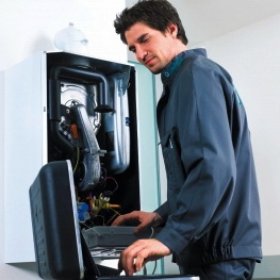
The comfort of the owners of a private house, especially in winter, directly depends on the serviceability of the heating system, and the faultless operation of the heating boiler is guaranteed only if all its parts are kept in good order. Sometimes the functioning of the equipment is disturbed for a very trivial reason - due to the contamination of some parts, for example, a gas column or heat exchanger. Let's consider whether it is possible to clean the gas boiler on our own and whether it is safe.
Pipes through which hot liquid circulates, sooner or later from the inside, become coated. This process is reminiscent of the settling of lime on the walls of the kettle: the thicker the layer of scale, the slower it heats up. Deposition of salts on the walls of the heat exchanger can cause problems.
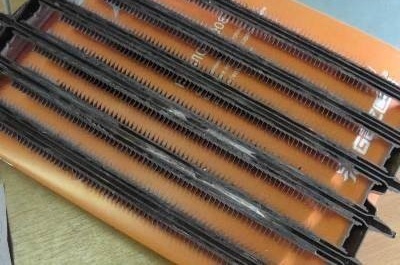
This will look like clogged pipes of the heat exchanger (sectional view) if regular maintenance and cleaning of the internal channels are not carried out
Are these troubles so great? Look at what awaits you if you do not timely flush the lines:
- Overheat. The gas boiler is designed in such a way that the coolant during the reverse movement must cool the internal parts of the heating elements. Limescale interferes with proper cooling, so the equipment may break at any time.
- Damage to important parts. For example, narrowing the diameter of the pipes leads to an increase in the ultimate load on the circulation pump, as a result of which it can also fail.
- Increase fuel consumption. Due to deposits, the thermal conductivity of the pipes decreases sharply, and for the necessary heating of the liquid, a greater amount of energy is required, that is, the gas flow increases. Accordingly, the cost of operating a gas boiler will also increase.
To avoid these troubles, it is necessary to regularly flush.
The frequency of the procedure depends on the fluid that is used as the coolant. Suppose an antifreeze heating system needs to be cleaned about once every 2 years, while it is necessary to monitor the quality of the liquid and, if necessary, completely replace it. Pipes in which purified water circulates should be washed once every 3-4 years. The higher the fluid hardness, the more often the cleaning measures.
Content
Heat exchanger flushing methods
When choosing a washing method, they usually focus on their own capabilities and knowledge. Let us dwell on three generally accepted methods.
Method # 1 - Manual Cleaning
To perform it, it is necessary to carefully remove the heat exchanger from the boiler, otherwise there will be no free access to contaminated surfaces.Next, we choose either mechanical cleaning or rinsing with solutions. For mechanical removal of deposits, a scraper, brush and vacuum cleaner are required. For flushing, which is good for double-circuit boilers, a salt-dissolving liquid.
With a manual cleaning method, all actions must be neat and careful. Mounting the heat exchanger in place, carefully check the tightness of the connections.
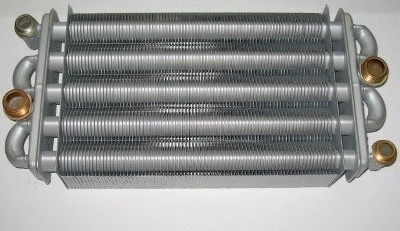
After removing the heat exchanger from the boiler body, you will understand that the inner surface of its main part, the bent pipe, needs to be cleaned, and manual cleaning will be extremely problematic
Method # 2 - chemical solution through a booster
It involves the use of special equipment - a booster, with which an acid wash solution is pumped into the heat exchanger. For a long time, it is run through the pipes several times, as a result, the coating dissolves and is discharged together with the flushing liquid. As a result, throughput and thermal conductivity indicators increase. Even the most persistent impurities succumb to the acid solution - salt deposits of carbonate and deposits of ferric iron. Residual acid in the pipes is neutralized with a special solution, which is finally launched into the heat exchanger.
Method # 3 - hydrodynamic flushing
It does not require disassembling equipment. It consists in pumping water (in some cases with an abrasive filler) and subsequent pressure pumping. The movement of fluid at an increased speed causes the destruction of sediments, which as a result are brought out. There is a risk of exceeding critical pressure values, which can result in pipe rupture.
Self-cleaning of the heat exchanger is not recommended. The best solution is to turn to professionals with access to gas equipment. Knowing the methods and sequence of cleaning, you can control the work of specialists.
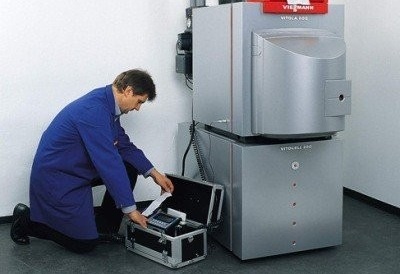
Prevention and repair of gas equipment by specialists guarantees that high-quality equipment, proven materials, safe technologies will be used - and all this in compliance with the norms
Cleaning the boiler from soot
Along with cleaning the chimney, the channels of the gas boiler itself are also cleaned. If the chimney becomes dirty and there are problems with draft, the equipment will automatically shut off. When soot accumulates inside the boiler, the shutdown does not occur, and the residents of the house can be poisoned by combustion products. In addition, contaminated equipment does not function properly, therefore it is recommended that the cleaning procedure be performed annually, especially for boilers operating year-round.
Soot removal and removal
To remove the boiler parts and clean them, you need a simple set of tools:
- screwdriver;
- brushes (soft and metal);
- brush;
- open-end wrenches (No. 8-17);
- rags.
Performing the steps in sequence, you can completely clean the internal parts of the gas column and prevent an accident or smoke in the room.

Use any tools with which you can remove limescale from a metal surface, and also not do without wrenches
So, the first thing to do is shut off the gas. Then we remove the boiler door and disconnect the wire leading to the piezoelectric element. Then, one by one we unscrew the thermocouple, the ignition electrode and the pilot burner tube. The position of the nozzle in the burner is better noted so as not to disturb the setting. The gasket located under the pilot burner should be replaced with a new one. Carefully remove the nozzle, copper tube, and after it the burner by unscrewing the set of clips.
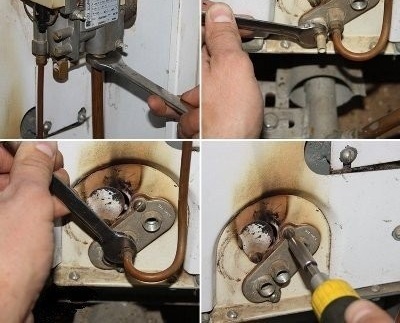
To unscrew the nuts of fixation of the copper tube, a wrench No. 17 is suitable, removal of the ignition electrode is No. 10, and unscrewing the screws securing the pilot burner is a flat screwdriver
Having removed the thermometer sleeve, remove the boiler cover along with the insulating sheet. Then we get the flue, having previously disconnected the terminals from the traction sensor. Swirls taken out of the heat exchanger are cleaned with a brush. Similarly, clean the base and the outside of the heat exchanger. We purge the internal channels with a vacuum cleaner.
To clean the burner we use brushes and a brush. The flue must be wiped from all sides. Particular attention is required to clean the nozzle: it is enough to clean the outer surface with a brush, and for the hole you need a thin needle, the diameter of which is less than the diameter of the hole. If you accidentally increase the width of the hole, the combustion mode is violated.
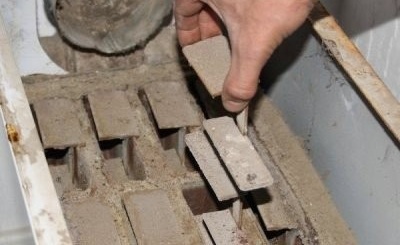
All elements of the heat exchanger, internal and external, must be cleaned with a stiff brush for metal. It is convenient to remove settled dust and residual lime with a vacuum cleaner and a damp cloth.
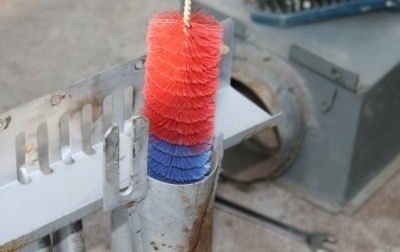
The brush is ideally suited for cleaning plaque of internal surfaces of any shape - heat exchanger elements, copper tube. The longer the handle. the more convenient it is to reach hard-to-reach places
Reverse assembly
We return to the place of the main burner, copper pipe and nozzle. Then we install a pilot burner on a new gasket, having previously cleaned it with a metal brush. When attaching the ignition electrode, it is better not to use the key, but to act manually so as not to damage the ceramic base. The remaining parts are also fixed in place. As a control check, we use soaping of the compounds. The tightness of the fixation of copper tubes and burners can only be checked during switching on.

When assembling the pilot burner, one rule should be remembered: the tip of the thermocouple should be opposite the place where the flame tongue appears
Preventive and cleaning work is best done on the eve of the heating season. In any case, the parts will be covered with soot, which accumulates over time, so the cleaning procedure for the elements of the gas boiler is very important - both for the effective functioning of the boiler itself and for the safety of the residents of the house. And once again we remind you that it is better to entrust any work with gas equipment to specialists!
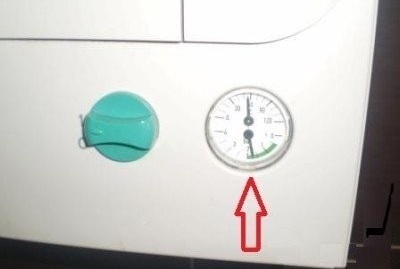
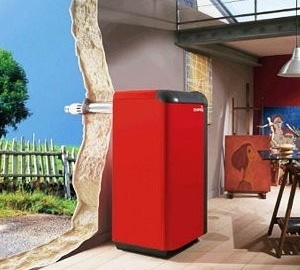
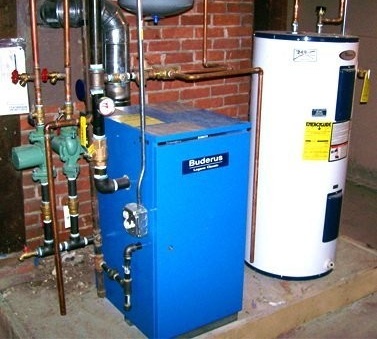
3 comments